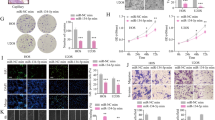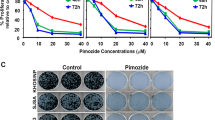Abstract
Osteosarcoma (OS) is the most common primary malignancy of bone. There is a critical need to identify the events that lead to the poorly understood mechanism of OS development and metastasis. The goal of this investigation is to identify and characterize a novel marker of OS progression. We have established and characterized a highly metastatic OS subline that is derived from the less metastatic human MG63 line through serial passages in nude mice via intratibial injections. Microarray analysis of the parental MG63, the highly metastatic MG63.2 subline, as well as the corresponding primary tumors and pulmonary metastases revealed insulin-like growth factor binding protein 5 (IGFBP5) to be one of the significantly downregulated genes in the metastatic subline. Confirmatory quantitative RT–PCR on 20 genes of interest demonstrated IGFBP5 to be the most differentially expressed and was therefore chosen to be one of the genes for further investigation. Adenoviral mediated overexpression and knockdown of IGFBP5 in the MG63 and MG63.2 cell lines, as well as other OS lines (143B and MNNG/HOS) that are independent of our MG63 lines, were employed to examine the role of IGFBP5. We found that overexpression of IGFBP5 inhibited in vitro cell proliferation, migration and invasion of OS cells. Additionally, IGFBP5 overexpression promoted apoptosis and cell cycle arrest in the G1 phase. In an orthotopic xenograft animal model, overexpression of IGFBP5 inhibited OS tumor growth and pulmonary metastases. Conversely, siRNA-mediated knockdown of IGFBP5 promoted OS tumor growth and pulmonary metastases in vivo. Immunohistochemical staining of patient-matched primary and metastatic OS samples demonstrated decreased IGFBP5 expression in the metastases. These results suggest 1) a role for IGFBP5 as a novel marker that has an important role in the pathogenesis of OS, and 2) that the loss of IGFBP5 function may contribute to more metastatic phenotypes in OS.
This is a preview of subscription content, access via your institution
Access options
Subscribe to this journal
Receive 50 print issues and online access
$259.00 per year
only $5.18 per issue
Buy this article
- Purchase on Springer Link
- Instant access to full article PDF
Prices may be subject to local taxes which are calculated during checkout






Similar content being viewed by others
References
Akkiprik M, Feng Y, Wang H, Chen K, Hu L, Sahin A et al. (2008). Multifunctional roles of insulin-like growth factor binding protein 5 in breast cancer. Breast Cancer Res 10: 212.
Amaar YG, Thompson GR, Linkhart TA, Chen ST, Baylink DJ, Mohan S . (2002). Insulin-like growth factor-binding protein 5 (IGFBP-5) interacts with a four and a half LIM protein 2 (FHL2). J Biol Chem 277: 12053–12060.
Avnet S, Sciacca L, Salerno M, Gancitano G, Cassarino MF, Longhi A et al. (2009). Insulin receptor isoform A and insulin-like growth factor II as additional treatment targets in human osteosarcoma. Cancer Res 69: 2443–2452.
Butt AJ, Dickson KA, Jambazov S, Baxter RC . (2005). Enhancement of tumor necrosis factor-alpha-induced growth inhibition by insulin-like growth factor-binding protein-5 (IGFBP-5), but not IGFBP-3 in human breast cancer cells. Endocrinology 146: 3113–3122.
Butt AJ, Dickson KA, McDougall F, Baxter RC . (2003). Insulin-like growth factor-binding protein-5 inhibits the growth of human breast cancer cells in vitro and in vivo. J Biol Chem 278: 29676–29685.
Cheung C, Vesey D, Cotterill A, Douglas M, Gobe G, Nicol D et al. (2005). Altered messenger RNA and protein expressions for insulin-like growth factor family members in clear cell and papillary renal cell carcinomas. Int J Urol 12: 17–28.
Davis AM, Bell RS, Goodwin PJ . (1994). Prognostic factors in osteosarcoma: a critical review. J Clin Oncol 12: 423–431.
Fuchs B, Pritchard DJ . (2002). Etiology of osteosarcoma. Clin Orthop 397: 40–52.
He TC, Zhou S, da Costa LT, Yu J, Kinzler KW, Vogelstein B . (1998). A simplified system for generating recombinant adenoviruses. Proc Natl Acad Sci USA 95: 2509–2514.
Kang Q, Song WX, Luo Q, Tang N, Luo J, Luo X et al. (2009). A comprehensive analysis of the dual roles of BMPs in regulating adipogenic and osteogenic differentiation of mesenchymal progenitor cells. Stem Cells Dev 18: 545–559.
Kang Q, Sun MH, Cheng H, Peng Y, Montag AG, Deyrup AT et al. (2004). Characterization of the distinct orthotopic bone-forming activity of 14 BMPs using recombinant adenovirus-mediated gene delivery. Gene Ther 11: 1312–1320.
Kaste SC, Pratt CB, Cain AM, Jones-Wallace DJ, Rao BN . (1999). Metastases detected at the time of diagnosis of primary pediatric extremity osteosarcoma at diagnosis: imaging features. Cancer 86: 1602–1608.
Letson GD, Muro-Cacho CA . (2001). Genetic and molecular abnormalities in tumors of the bone and soft tissues. Cancer Control 8: 239–251.
Luo J, Deng ZL, Luo X, Tang N, Song WX, Chen J et al. (2007a). A protocol for rapid generation of recombinant adenoviruses using the AdEasy system. Nat Protoc 2: 1236–1247.
Luo Q, Kang Q, Si W, Jiang W, Park JK, Peng Y et al. (2004). Connective tissue growth factor (CTGF) is regulated by Wnt and bone morphogenetic proteins signaling in osteoblast differentiation of mesenchymal stem cells. J Biol Chem 279: 55958–55968.
Luo Q, Kang Q, Song WX, Luu HH, Luo X, An N et al. (2007b). Selection and validation of optimal siRNA target sites for RNAi-mediated gene silencing. Gene 395: 160–169.
Luo X, Sharff KA, Chen J, He TC, Luu HH . (2008). S100A6 expression and function in human osteosarcoma. Clin Orthop Relat Res 466: 2060–2070.
Luu HH, Kang Q, Park JK, Si W, Luo Q, Jiang W et al. (2005a). An orthotopic model of human osteosarcoma growth and spontaneous pulmonary metastasis. Clin Exp Metastasis 22: 319–329.
Luu HH, Zagaja GP, Dubauskas Z, Chen SL, Smith RC, Watabe K et al. (1998). Identification of a novel metastasis-suppressor region on human chromosome 12. Cancer Res 58: 3561–3565.
Luu HH, Zhou L, Haydon RC, Deyrup AT, Montag AG, Huo D et al. (2005b). Increased expression of S100A6 is associated with decreased metastasis and inhibition of cell migration and anchorage independent growth in human osteosarcoma. Cancer Lett 229: 135–148.
Manara MC, Landuzzi L, Nanni P, Nicoletti G, Zambelli D, Lollini PL et al. (2007). Preclinical in vivo study of new insulin-like growth factor-I receptor--specific inhibitor in Ewing's sarcoma. Clin Cancer Res 13: 1322–1330.
Mankin HJ, Hornicek FJ, Rosenberg AE, Harmon DC, Gebhardt MC . (2004). Survival data for 648 patients with osteosarcoma treated at one institution. Clin Orthop 429: 286–291.
Mukherjee A, Rotwein P . (2007). Insulin-like growth factor binding protein-5 in osteogenesis: facilitator or inhibitor? Growth Horm IGF Res 17: 179–185.
Peng Y, Kang Q, Luo Q, Jiang W, Si W, Liu BA et al. (2004). Inhibitor of DNA binding/differentiation helix-loop-helix proteins mediate bone morphogenetic protein-induced osteoblast differentiation of mesenchymal stem cells. J Biol Chem 279: 32941–32949.
Ragland BD, Bell WC, Lopez RR, Siegal GP . (2002). Cytogenetics and molecular biology of osteosarcoma. Lab Invest 82: 365–373.
Rosenzweig SA . (2004). What's new in the IGF-binding proteins? Growth Horm IGF Res 14: 329–336.
Schedlich LJ, Le Page SL, Firth SM, Briggs LJ, Jans DA, Baxter RC . (2000). Nuclear import of insulin-like growth factor-binding protein-3 and -5 is mediated by the importin beta subunit. J Biol Chem 275: 23462–23470.
Schneider MR, Wolf E, Hoeflich A, Lahm H . (2002). IGF-binding protein-5: flexible player in the IGF system and effector on its own. J Endocrinol 172: 423–440.
Schneider MR, Zhou R, Hoeflich A, Krebs O, Schmidt J, Mohan S et al. (2001). Insulin-like growth factor-binding protein-5 inhibits growth and induces differentiation of mouse osteosarcoma cells. Biochem Biophys Res Commun 288: 435–442.
Sharff KA, Song WX, Luo X, Tang N, Luo J, Chen J et al. (2009). Hey1 basic helix-loop-helix protein plays an important role in mediating BMP9-induced osteogenic differentiation of mesenchymal progenitor cells. J Biol Chem 284: 649–659.
Song H, Shand JH, Beattie J, Flint DJ, Allan GJ . (2001). The carboxy-terminal domain of IGF-binding protein-5 inhibits heparin binding to a site in the central domain. J Mol Endocrinol 26: 229–239.
Stolf BS, Carvalho AF, Martins WK, Runza FB, Brun M, Hirata Jr R et al. (2003). Differential expression of IGFBP-5 and two human ESTs in thyroid glands with goiter, adenoma and papillary or follicular carcinomas. Cancer Lett 191: 193–202.
Su Y, Luo X, He BC, Wang Y, Chen L, Zuo GW et al. (2009). Establishment and characterization of a new highly metastatic human osteosarcoma cell line. Clin Exp Metastasis 26: 599–610.
Takahashi M, Papavero V, Yuhas J, Kort E, Kanayama HO, Kagawa S et al. (2005). Altered expression of members of the IGF-axis in clear cell renal cell carcinoma. Int J Oncol 26: 923–931.
Tusher VG, Tibshirani R, Chu G . (2001). Significance analysis of microarrays applied to the ionizing radiation response. Proc Natl Acad Sci USA 98: 5116–5121.
Wang H, Rosen DG, Fuller GN, Zhang W, Liu J . (2006). Insulin-like growth factor-binding protein 2 and 5 are differentially regulated in ovarian cancer of different histologic types. Mod Pathol 19: 1149–1156.
Whelan JS . (1997). Osteosarcoma. Eur J Cancer 33: 1611–1618; discussion 1618–9.
Xu C, Graf LF, Fazli L, Coleman IM, Mauldin DE, Li D et al. (2007). Regulation of global gene expression in the bone marrow microenvironment by androgen: androgen ablation increases insulin-like growth factor binding protein-5 expression. Prostate 67: 1621–1629.
Yonemoto T, Tatezaki S, Ishii T, Satoh T, Kimura H, Iwai N . (1998). Prognosis of osteosarcoma with pulmonary metastases at initial presentation is not dismal. Clin Orthop 349: 194–199.
Acknowledgements
We thank Dr Xinmin Li, PhD (Director of The UCLA Clinical Microarray Core) for his help with the microarray and cluster analysis. We also sincerely thank Dr Anthony Montag, Leslie Martin and Guarav Luther for the creation of the tissue array. We also thank Dr Theodore Karrison for help with the statistical analysis. This work was supported in part by research grants from The American Cancer Society (HHL and TCH), the Brinson Foundation (HHL, TCH, RCH), The National Institute of Health (HHL, TCH, RCH), the Orthopaedic Research and Education Foundation (HHL, RCH), the Natural Science Foundation of China (#81001197 to YS), and the 973 Program of the Ministry of Science and Technology of China (#2011CB707906 to JL and TCH).
Author information
Authors and Affiliations
Corresponding author
Ethics declarations
Competing interests
The authors declare no conflict of interest.
Rights and permissions
About this article
Cite this article
Su, Y., Wagner, E., Luo, Q. et al. Insulin-like growth factor binding protein 5 suppresses tumor growth and metastasis of human osteosarcoma. Oncogene 30, 3907–3917 (2011). https://doi.org/10.1038/onc.2011.97
Received:
Revised:
Accepted:
Published:
Issue Date:
DOI: https://doi.org/10.1038/onc.2011.97
Keywords
This article is cited by
-
IGFBP5 increases cell invasion and inhibits cell proliferation by EMT and Akt signaling pathway in Glioblastoma multiforme cells
Cell Division (2020)
-
Melatonin: an anti-tumor agent for osteosarcoma
Cancer Cell International (2019)
-
A blockade of PI3Kγ signaling effectively mitigates angiotensin II-induced renal injury and fibrosis in a mouse model
Scientific Reports (2018)
-
Detection of Molecular Alterations in Taiwanese Patients with Medullary Thyroid Cancer Using Whole-Exome Sequencing
Endocrine Pathology (2018)
-
Role of estrogen receptors and Src signaling in mechanisms of bone metastasis by estrogen receptor positive breast cancers
Journal of Translational Medicine (2017)



